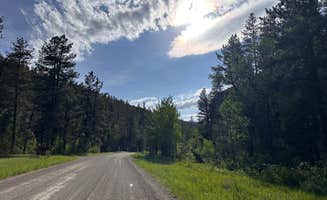Dispersed camping near Hobson, Montana offers primitive, no-fee options primarily on Lewis and Clark National Forest land. The region sits at elevations ranging from 4,100-5,200 feet with seasonal creek flows dependent on mountain snowmelt and spring precipitation. Winter temperatures regularly drop below zero, while summer daytime highs typically reach 75-85°F with cool nights even during peak season.
What to do
Fishing opportunities: Belt Creek provides trout fishing access directly from several camping areas. Belt Creek on Hughesville Road sites are positioned along the waterway. "You can park right on the stream there are fire rings and man is it quiet!" notes reviewer StaceeQ.
Wildlife viewing: Early mornings offer the best chances to spot deer, elk, and various bird species. Slaughter River camping areas provide flat terrain with good visibility. According to one camper, "Fishing is good though, and at night you can catch catfish!"
Historical exploration: Visit remnants of mining operations and homesteader cabins in the surrounding area. Several primitive roads lead to abandoned structures from the early 1900s. Dispersed Site 9210 occupies "the site of the former Indian Hills Campground which was decommissioned a few years ago" according to reviewer Dexter.
What campers like
Creek-side camping: Direct water access remains the most praised feature of Belt Creek dispersed sites. A visitor mentioned, "We found a nice spot a few miles back and right next to the creek."
Established fire rings: Many sites include pre-existing fire rings despite the lack of other amenities. As one camper noted at Slaughter River Boat Camp, the "site is an fenced area with two vault toilets, one shelter and five metal fire rings."
Solitude on weekdays: Mid-week visits, particularly in shoulder seasons, offer better site selection and fewer neighbors. "We were there mid-week in September and I was surprised at how many other campers were there, but there were still several sites that were available."
Accessibility: Most areas feature relatively well-maintained access roads suitable for standard vehicles. One reviewer commented, "The road was in great shape" and another noted "the road is well maintained."
What you should know
Limited amenities: No developed campgrounds provide water, toilets, or garbage service except Slaughter River. Pack in all water and pack out all trash. A Slaughter River camper warns, "the toilets have no toilet paper so BRING YOUR OWN!!!"
Campsite availability: Popular sites fill quickly on summer weekends. "We arrived at about 5 on a Friday night and a lot of the spots where taken. Traffic kept rolling until about 9 of people looking for spots," reports one Haymaker Dispersed Camping Area visitor.
Trash problems: Multiple camping areas suffer from previous visitors leaving garbage behind. One camper observed, "My only two complaints is people leave their trash. So pack out what you bring in."
Weather preparedness: Rapid temperature changes and afternoon thunderstorms occur frequently in summer months. Nighttime temperatures can drop below freezing even in July and August at higher elevations.
Tips for camping with families
Secondary roads for quieter camping: Main road sites fill quickly, but side roads often have available spots. "If everything by the road is taken just drive down a side road and you will probably find something!" advises one camper.
Creek safety: Water levels and flow rates vary dramatically by season. Spring runoff creates dangerous conditions for children playing near Belt Creek through June.
Cell service limitations: Most dispersed camping areas have no reliable cellular coverage. Download offline maps before arrival and establish meeting points/times if splitting up.
Shade availability: Timber Creek Dispersed Campground offers tree cover at most sites, while Belt Creek areas have partial shade. One camper at Dispersed Site 9210 notes sites "sit among very large trees and along side the creek."
Tips from RVers
Length restrictions: Most pull-offs accommodate smaller trailers and campers under 25 feet. Larger RVs should scout sites before attempting access, particularly on side roads.
Leveling challenges: Bring leveling blocks as most sites feature uneven terrain. Most established pull-offs require some adjustment for comfortable parking.
Generator courtesy: No formal rules restrict generator use, but the small size of camping areas makes noise highly noticeable to neighbors. Limit run times to mid-day hours when most campers are away from their sites.
Turnaround space: Some roads narrow significantly after first camping areas. Larger rigs should avoid proceeding past initial sites without confirming adequate turnaround space ahead.



